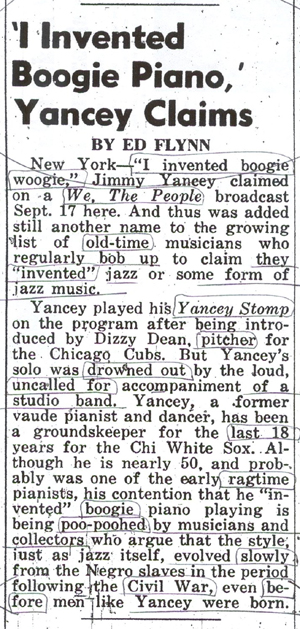
Jimmy Yancey was NOT the "Progenitor of Boogie-Woogie Piano"
by John Tennison, MD
In 1940 Jimmy Yancey falsely claimed that he "invented" Boogie Woogie piano.
Here is the article from the October 1, 1940 issue of Down Beat, in which Yancey's claim of having "invented Boogie Woogie" piano was correctly regarded as false by experts of the day:

Jimmy Yancey's "contention that he 'invented' boogie piano playing is being poo-poohed by musicians and collectors who argue that the style, just as jazz itself, evolved slowly from the Negro slaves in the period following the Civil War, even before men like Yancey were born." -- Ed Flynn, Down Beat, October 1, 1940
Moreover, in 1943, on page 25 of "This is Jazz: A Series of Lectures Given At The San Francisco Museum of Art," Rudi Blesh states the following about Boogie Woogie: "It is popularly supposed to have originated around Chicago with the pianist Jimmy Yancey. It seems more probable that Yancey while on tour as a tap dancer with a minstrel show first heard it in the South." and on pages (25-26): "Much has been said about Chicago Jazz that would indicate that it is a separate style of Jazz. This simply isn't true, and the fact is beginning to be recognized." and "They were hearing it and they were trying to play it themselves. And their attempts, partly successful, partly not, are all there is to Chicago style. The rest is the opinion of people who had heard a lot of this copy-work but little or nothing of the original New Orleans model, and the result was the recording company build-up."
Jimmy Yancey was an object of such "build-up" on the part of Ahmet Ertegun and Atlantic Records. Consequently, Yancey was among the first inductees into the Rock and Roll Hall of Fame in 1986, while as of 2011, Albert Ammons, Pete Johnson, and Meade Lux Lewis (whose recordings were far more influential to the sound of Rock and Roll) have still not been inducted into the Hall of Fame.
In his
1969 book, The Story of The Blues,
Paul Oliver
writes the following:
"Ten years in vaudeville even brought him [Yancey] to
England, but returning to chicago in 1913, he took a job as ground-keeper at the
White Sox baseball park on 35th Street and developed his blues. Perhaps his
vaudeville tours took him to New Orleans or Mexico for his playing always
demonstrated the 'Spanish tinge' which Jelly Roll Morton had considered an
important component of jazz." -- page 90,
The Story
of The Blues
and
"Jimmy Yancey's bass figures sometimes had a tango and
habanera rhythm which relate them to the music of the legendary Doug Suggs and
Little David Alexander. Doug sougs was the same age as Yancey, being born in
1894 in St. Louis where he was influenced by the playing of Claude Brown; later
he moved to Chicago and also took a job at the Sox ball park, working as a
porter. Contact between the two musicians must have helped develop their similar
use of bass patterns, but Suggs, though less known in later years than Yancey,
was an important influence on the younger generation of Chicago pianists." --
page 90-91,
The Story of The Blues
Modern-day experts (including John Tennison) continue to agree with experts cited in the 1940 Down Beat article, with Rudi Blesh, and with Paul Oliver.
See the Red Hot Jazz Archive Article on Jimmy Yancey.
When visiting the Rock and Roll Hall of Fame, please remind the staff that Jimmy Yancey was not "the progenitor of Boogie-Woogie piano," as the Rock and Roll Hall of Fame falsely claims.